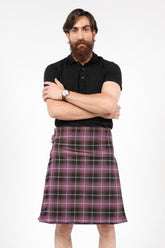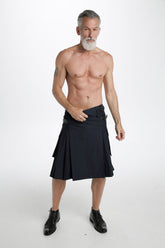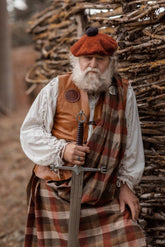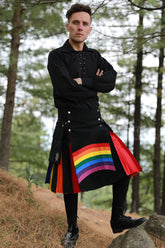How is Hogmanay in Scotland Celebrated?
What is Hogmanay?
Hogmanay, the Scottish term for the "last day of the year," is a vibrant and unique New Year celebration, blending Norse winter solstice and Celtic fire festival traditions. Observed on December 31st, it is followed by additional celebrations on New Year's Day and, in some cases, January 2nd. The origins of this tradition are unclear, potentially derived from Norse and Gaelic observances of the winter solstice. It is marked by various customs and traditions, including gift-giving, visiting friends and neighbors, and placing emphasis on the "first foot," representing the first guest of the new year. The celebration elements encompass reflection, late-night partying, family gatherings, feasting, gift exchanges, fireworks, countdowns, watch-night services, and social gatherings. It is celebrated all over Scotland, attracting visitors from around the world, and is characterized by diverse traditions.

Hogmanay Traditions!
Here are some Hogmanay Traditions. To Celebrate the Spirit of New Beginnings:
First Footing Tradition:
"First Footing" is a unique Scottish tradition, where the first person to enter a household after midnight is believed to bring good luck for the coming year. This tradition dates back to Scotland's encounters with the Vikings and the Norsemen's emphasis on the Winter Solstice. The first foot should ideally be a dark-haired male, symbolizing a throwback to Viking days when a big blonde stranger arriving on your doorstep with a big axe meant big trouble. To ensure good luck for the house, The first foot is expected to bring symbolic gifts such as coal, shortbread, salt, black bun, and whisky, representing prosperity, warmth, and good cheer for the household. The tradition emphasizes the importance of warm hospitality and the exchange of gifts to ensure good fortune for the upcoming year.
Edinburgh Event:
It is a three-day festival that celebrates New Year's Eve in Scotland's capital city. The festival includes a torchlight procession, live music concerts, family events, a massive outdoor street party, and unforgettable fireworks. The Hogmanay Street Party is one of the world's greatest New Year celebrations, featuring live entertainment and a spectacular midnight fireworks display. The festival also offers pre-event dining experiences, silent disco parties, and indoor parties. The festival culminates in a family-friendly ceilidh on January 1st. Edinburgh's Hogmanay has been highlighted as one of the "Top 100 things to do before you die" and is the only festival to make the list. Celebrating its 30th anniversary in 2023, Edinburgh's Hogmanay is where the world comes to party.

Redding the House:
The significance of "redding the house" on Hogmanay lies in the tradition of preparing for the New Year by cleaning and tidying the home, symbolizing a fresh start and the casting away of the old. This custom, rooted in Scottish tradition, involves thorough housecleaning, removal of ashes from the fireplace, and settling of debts before the stroke of midnight on December 31st. It is believed that starting the New Year with a clean and orderly house, along with finances in order, brings good luck and sets a positive tone for the year ahead. The act of "redding the house" is a symbolic way of bidding farewell to the past year and welcoming the new one with a clear conscience and optimistic spirit.
Baking a black bun:
The black bun is a traditional Scottish fruit cake, often enjoyed during the new year celebrations, which mark the Scottish New Year. Originally known as the Scots' Twelfth Cake, it was associated with the Twelfth Night of Christmas. However, after the banning of Christmas and its subsidiary festivals, the tradition was transferred to the Hogmanay festivities, making it a significant part of the Scottish New Year's customs. This rich fruit cake, encased in pastry, is a key food to serve at Hogmanay gatherings and is often enjoyed with a cup of whisky or brandy. The process of making a black bun involves several steps, including:
- Preparing the pastry: Combining flour, salt, and butter to create a stiff dough.
- Preparing the filling: Mixing raisins, currants, almonds, peel, and sugar, then binding them with brandy and egg.
- Assembling the cake: Lining a tin with pastry, filling it with the mixture, and topping it with more pastry. Pinch the edges to seal the cake and create a glaze with milk or egg.
- Baking: Place the cake in a pre-heated oven at 325°F (160°C) for 2 to 3 hours, or until a skewer inserted into the bottom comes out clean.

The result is a moist, fruity cake that is perfect for sharing with friends and family during festivities.
Wearing Traditional Kilts:
Wearing kilts, particularly those representing clan tartans, is a key aspect of this day festivities, showcasing Scottish pride. Man kilt is a long-standing and much-respected emblem of Scotland, and it is worn at various events, including weddings, christenings, and military parades. Hogmanay is a blend of the Norse winter solstice and the Celtic fire festival, and it is a huge event in Scotland. Wearing a kilt on Hogmanay is a way to showcase your heritage and immerse yourself in the Scottish culture. You can choose any type of kilt, but traditionally, the kilts that are worn are the ones that represent the clan or regional Scottish clan tartans. Whether you opt for a formal Highland Dress and kilted jacket or keep it simple with a casual kilt, pairing it with a dress shirt, a casual shirt, or a T-shirt, you will undoubtedly stand out and add a touch of authenticity to your celebration.

Lighting the fireplace:
Hogmanay, the Scottish New Year's Eve celebration, is steeped in tradition, and one such tradition is the lighting of the fireplace. This act holds great significance, symbolizing the light of the sun to ward off evil spirits. The warmth and glow of the fire not only provide comfort but also represent hope and positivity for the coming year. As the flames flicker and the embers glow, it brings people together, fostering a sense of connection and community. The practice of lighting the fireplace on Hogmanay is a time-honored custom that has been passed down through generations, reflecting the rich history and cultural heritage of Scotland. So, as you kindle the fire, you are not only embracing a tradition but also ushering in the new year with warmth, light, and a sense of togetherness.
Auld Lang Syne: Singing in the New Year
"Auld Lang Syne" on Hogmanay is a time-honored Scottish tradition, marking the end of the old year and the beginning of the new. As the clock strikes midnight, friends and family join hands, singing the familiar tune that celebrates the enduring bonds of friendship and the memories of days gone by. This heartwarming custom, observed during the Hogmanay festivities, embodies the spirit of reflection and hope for the future. The lively and joyous atmosphere of Hogmanay, coupled with the poignant lyrics of "Auld Lang Syne," creates a truly unforgettable experience. The song's lyrics are attributed to Robert Burns, the national poet of Scotland, who wrote them in 1788. The poem was based on an older Scottish folk song, and in 1799, it was set to a traditional tune that has since become standard. The title of the song, translated literally into standard English, is "Old Long Since," which can be interpreted as "since long ago" or "for old times' sake." The lyrics are about old friends having a drink and recalling adventures they had long ago. It's a time to cherish the present, honor the past, and embrace the opportunities that the new year brings.
Traditional New Year Dinner:
The Scottish New Year's Eve celebration, is steeped in tradition, especially when it comes to the food. The traditional New Year dinner on Hogmanay is a hearty and warming affair, featuring dishes that are perfect for the cold time of year. One of the most iconic dishes is the Steak Pie, served with roast tatties and vegetables, ideal for soaking up the revelry of the previous night. Other traditional delicacies include black bun, a rich fruit cake, and Scotch Broth or Spicy Lentil Soup as starters. These dishes reflect the warmth and hospitality of Scottish culture, making it a truly unforgettable experience.
Stonehaven's Fireball Tradition:
Stonehaven in North East Scotland has a tradition of creating giant fireballs from paraffin-soaked rags, swung on poles, and paraded through the streets during Hogmanay celebrations. The history behind this tradition is rooted in the belief that fire has the power to purify and cleanse. This unique celebration, which has been celebrated for at least a century, is believed to have its origins in the fishing community and seaport of Stonehaven. The event symbolizes the burning off of evil spirits, allowing the new year to begin with a fresh start. The ceremony involves local people of all ages swinging flaming wire cages filled with combustible material. The idea is to burn off the bad spirits left from the old year so that the spirits of the new year can come in clean and fresh. The event starts at midnight and lasts for approximately 20 minutes, with thousands of spectators lining the High Street to watch the spectacular display. The fireballs are then hurled into the harbor, marking the end of the ceremony and the beginning of the New Year's celebrations.
Loony Dook:
The Loony Dook is a wacky and invigorating tradition where participants plunge into the chilly waters of the Firth of Forth in Scotland, often in colorful costumes. Despite its cancellation in 2021, 2022, and 2023, this quirky event typically draws a large crowd of enthusiastic "Dookers" who embrace the New Year with a refreshing dip. The name "Loony Dook" itself reflects the lighthearted and adventurous spirit of the occasion, combining "Loony" (short for "lunatic") and "Dook," a Scots term for "dip" or "bathe." While the official event may not be happening, the Loony Dook remains a unique and memorable way to welcome the New Year in Scotland.
The Burning of the Clavie:
The Burning of the Clavie is a unique and ancient tradition that takes place in Burghead, Scotland, every Hogmanay. The event marks the occasion that Hogmanay was formerly celebrated in Scotland before the introduction of the Gregorian calendar in the 1700s. The significance of the 11th January dates back to the 1750s when the calendar was reformed in Britain, and the new Gregorian calendar was introduced. The Burning of the Clavie involves the burning of a wooden barrel filled with tar and wood shavings, known as the Clavie, which is carried through the streets of the town by a group of locals. Once the Clavie has burned out and falls down the hill, the crowds chase after the smoldering embers and gather them up for good luck. Possession of a piece of the Clavie is said to bring good luck for the coming year, and pieces are sent to villagers around the world.

Hogmanay Parade:
The Hogmanay Parade is a popular event in Scotland, and there are several routes that the parade takes. The most famous route is in Edinburgh, where the parade starts on the Royal Mile in the Old Town and winds down the Mound and across to New Town. The procession continues on Princes Street, past the Christmas markets and rides. The Torchlight Procession is a significant part of this day Parade, and it has a new route this year. The procession will begin at the Meadows for the first time ever, where guests will be entertained while collecting their torches, with live street theatre, fire performers, pipe bands, and drummers to start the celebrations early. Thousands of torch carriers will set off on the new route up Middle Meadow Walk, passing some of the capital's most famous landmarks, including the National Museum of Scotland, Greyfriars Kirk, and St Giles' Cathedral. Other cities in Scotland, such as Inverness and Aberdeen, also have their own Hogmanay celebrations with public festivals, live music, and dinners.
Torchlight Processions:
The Torchlight Procession on Hogmanay has a rich history rooted in tradition and community. Fire has long symbolized rebirth and new beginnings, with flames believed to ward off evil spirits. The procession, which marks the beginning of Edinburgh's Hogmanay celebrations, can be traced back to pre-Christian festivals when Vikings celebrated the winter solstice. The event has grown in popularity, attracting a sellout crowd of 20,000 people who carry torches to shine a light on homelessness, raising over £50,000 for charity. The procession winds through the historic Old Town, creating a spectacular sight with fire performers, pipe bands, and drummers, making it a truly unforgettable experience for participants and spectators alike. This tradition not only ushers in the New Year but also serves as a meaningful way to support the community and embrace the spirit of togetherness.
Hogmanay Celebrations Today:
It is a time of vibrant celebrations and age-old traditions. From the world-famous street party in Edinburgh to the warm and welcoming gatherings across Scotland, Hogmanay guarantees an unforgettable start to the new year. The festivities, which often continue into New Year's Day, include torchlight processions, gift giving, live music concerts, fireworks, and the world's largest rendition of Auld Lang Syne. With a history dating back to 1993, Edinburgh's Hogmanay has grown to become one of the greatest outdoor New Year celebrations globally, attracting visitors from all over the world. Whether you choose to join the massive street party in Edinburgh or the more intimate gatherings in other parts of Scotland, this day offers a truly magical way to welcome the new year.
The significance of giving symbolic gifts lies in the tradition's representation of good luck and well-wishes for the coming year. These gifts, such as shortbread, a silver coin, a lump of coal, and whisky, carry specific meanings, symbolizing warmth, prosperity, and hospitality. They are believed to bring good luck, health, and cheer to the recipient's household. The exchange of these symbolic gifts reflects the Scottish spirit of hospitality and the desire for a bountiful year ahead. This age-old custom is a meaningful way to convey goodwill and celebrate the new year with profound cultural significance.
Tradition of an Extra Holiday Day:
The Scottish New Year's Eve, is steeped in tradition, including the custom of an extra holiday day on January 2nd. This unique practice dates back to the 16th century when the Scottish Parliament reformed the calendar. The additional day off allows for extended celebrations, symbolizing a fresh start and a time for family and community. It's a time-honored tradition that continues to be cherished, offering an opportunity for people to come together, reflect on the past year, and look ahead to the future. The Hogmanay holiday is a blend of history, merriment, and togetherness, making it a truly special and distinctive way to welcome the new year.
Kilt Up for Hogmanay!
The Scottish New Year's celebration, is a perfect occasion to Kilt Up with Fashion Kilt. Embrace the tradition and style of the event by exploring our diverse range of men's kilts for sale, including tartan skirts, men's kilts in various styles, and custom-made options to honor your heritage. We take pride in creating visually stunning and comfortable kilts. With Hogmanay approaching, it's the perfect time to shop for the perfect men's kilt. At Fashion Kilt, customers can customize their kilts with buttons, tartan patterns, and big & tall sizes to make their Hogmanay more valuable and memorable. The kilts are available in various styles, including utility, hybrid, leather, and denim, to cater to different tastes and heritage. We offer a rush delivery service that guarantees delivery within two weeks to 10 days without compromising quality. Fashion Kilt stands firmly behind its products, and any inconvenience is covered by a comprehensive money-back guarantee. Join the festivities in style!
FAQs
Why do the Scottish call it Hogmanay?
It is the Scottish name for New Year's Eve celebrations. The origin of the word 'Hogmanay' itself is uncertain, but it is believed to come from the French word 'hoginane' meaning 'gala day'. It may have also entered the Scots language from French, Gaelic, Flemish, or Ancient English.
Where did Hogmanay come from?
It's origins are unclear, but it may be derived from Norse. It is believed that many of the traditional celebrations were originally brought to Scotland by the invading Vikings in the early 8th century. The celebration of Hogmanay in Scotland dates back to the 16th century, and it is thought to have first been used widely following Mary, Queen of Scots' return to Scotland from France in 1561.
Is it appropriate to say Happy Hogmanay?
Yes, it is appropriate to say as it is the Scottish name for New Year's Eve celebrations.
Is it okay to wear a kilt on Hogmanay?
Yes, it is okay to wear a kilt. It is a common tradition to wear kilts during these celebrations.
What is the difference between Christmas and Hogmanay?
While Christmas is celebrated on December 25th, Hogmanay is celebrated on December 31st, which is New Year's Eve. In Scotland, Christmas was not celebrated with the same enthusiasm as in other parts of the UK, and so the gift-giving and celebration that accompanied Christmas elsewhere took place at New Year, giving rise to the uniquely Scottish celebration of Hogmanay.
What is special about Hogmanay?
It is a big deal in Scotland, and it is celebrated with various traditions and customs. One of the most popular traditions is "first footing," which requires that the first visitor of the New Year should be a tall, dark-haired man who brings gifts such as coal, shortbread, and whisky. It is also traditional for people to clean their house and remove any old ashes in the fire, symbolizing clearing out the old year to welcome in the new one. Auld Lang Syne, a song written by Scottish poet Robert Burns, is often sung after the bell has struck midnight on New Year's Eve, as the new year begins.













